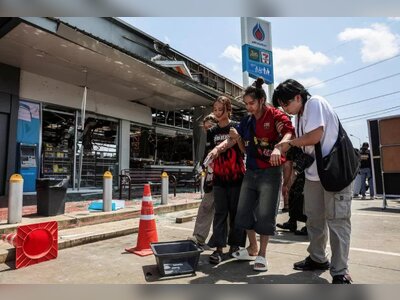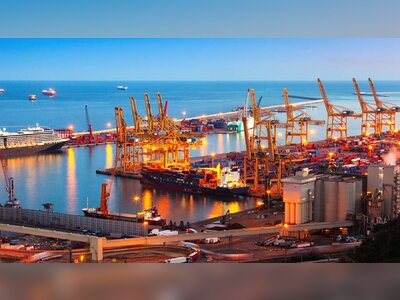Hua Lamphong Railway Station Marks 109 Years as Thailand's Historic Transport Landmark
Bangkok’s iconic railway station, inaugurated in 1916 under King Rama VI, commemorates 109 years of service and architectural legacy
Hua Lamphong Railway Station, officially known as Bangkok Railway Station, marked its 109th anniversary today.
Commissioned during the reign of King Chulalongkorn (Rama V) and inaugurated under King Vajiravudh (Rama VI) in 1916, the station has long served as a critical hub in Thailand's rail network and remains an enduring symbol of the nation’s transport history.
Constructed in the early 20th century, Hua Lamphong was designed by Italian architect Mario Tamagno, who also contributed to several landmark buildings in Thailand.
The station's architecture incorporates Italian Renaissance and neoclassical elements, with a half-dome design inspired by Frankfurt Central Station.
Interior features include marble columns, intricately carved teakwood ceilings, and stained-glass windows.
The main hall still houses a 160-centimetre clock powered by its original direct current system.
Located at the intersection of Rama IV and Krung Kasem roads, the station's front façade features a prominent relief of King Rama V and a statue of the three-headed elephant, Erawan—an important cultural and religious symbol in Thai tradition.
Hua Lamphong was the country’s primary passenger and freight terminal for much of the 20th century.
In 1960, freight services were relocated to Phahonyothin station in Bangkok’s Chatuchak district, reflecting changes in urban planning and transport logistics.
Despite the shift, Hua Lamphong continued to handle long-distance and commuter services, including trains to northern, northeastern, and southern Thailand.
In preparation for the 13th Asian Games hosted in Bangkok in 1998, the station underwent substantial restoration.
Renovations preserved the historical features while updating functionality, further enhancing its status as a national heritage site.
Although its role has diminished in recent years due to the development of new transportation hubs—such as Bang Sue Grand Station, which began operating as the main terminal for intercity trains in 2021—Hua Lamphong remains operational for some services.
It also continues to attract visitors and commuters, with ongoing usage by regional and suburban lines.
The station’s legacy is preserved by the State Railway of Thailand and continues to be featured in heritage and cultural programs.
It remains a focal point for historical tourism, architecture enthusiasts, and transportation scholars.
Commemorative events for the 109th anniversary include historical exhibitions, guided tours, and a railway-themed display curated in collaboration with Thai Railways.
The events aim to educate the public on the evolution of Thailand’s railway system and the cultural significance of Hua Lamphong in the national narrative.
The station’s enduring presence in central Bangkok underscores its architectural, cultural, and historical value.
It remains one of the most photographed and visited landmarks in the Thai capital, reflecting more than a century of continuity in the country's rail transport infrastructure.
Commissioned during the reign of King Chulalongkorn (Rama V) and inaugurated under King Vajiravudh (Rama VI) in 1916, the station has long served as a critical hub in Thailand's rail network and remains an enduring symbol of the nation’s transport history.
Constructed in the early 20th century, Hua Lamphong was designed by Italian architect Mario Tamagno, who also contributed to several landmark buildings in Thailand.
The station's architecture incorporates Italian Renaissance and neoclassical elements, with a half-dome design inspired by Frankfurt Central Station.
Interior features include marble columns, intricately carved teakwood ceilings, and stained-glass windows.
The main hall still houses a 160-centimetre clock powered by its original direct current system.
Located at the intersection of Rama IV and Krung Kasem roads, the station's front façade features a prominent relief of King Rama V and a statue of the three-headed elephant, Erawan—an important cultural and religious symbol in Thai tradition.
Hua Lamphong was the country’s primary passenger and freight terminal for much of the 20th century.
In 1960, freight services were relocated to Phahonyothin station in Bangkok’s Chatuchak district, reflecting changes in urban planning and transport logistics.
Despite the shift, Hua Lamphong continued to handle long-distance and commuter services, including trains to northern, northeastern, and southern Thailand.
In preparation for the 13th Asian Games hosted in Bangkok in 1998, the station underwent substantial restoration.
Renovations preserved the historical features while updating functionality, further enhancing its status as a national heritage site.
Although its role has diminished in recent years due to the development of new transportation hubs—such as Bang Sue Grand Station, which began operating as the main terminal for intercity trains in 2021—Hua Lamphong remains operational for some services.
It also continues to attract visitors and commuters, with ongoing usage by regional and suburban lines.
The station’s legacy is preserved by the State Railway of Thailand and continues to be featured in heritage and cultural programs.
It remains a focal point for historical tourism, architecture enthusiasts, and transportation scholars.
Commemorative events for the 109th anniversary include historical exhibitions, guided tours, and a railway-themed display curated in collaboration with Thai Railways.
The events aim to educate the public on the evolution of Thailand’s railway system and the cultural significance of Hua Lamphong in the national narrative.
The station’s enduring presence in central Bangkok underscores its architectural, cultural, and historical value.
It remains one of the most photographed and visited landmarks in the Thai capital, reflecting more than a century of continuity in the country's rail transport infrastructure.











